Ta Van Village is a tranquil and beautiful village, rich in the distinctive cultural identity of the local ethnic communities, and it has always been an unmissable destination for travelers visiting the misty town of Sapa. If you are planning to explore this region, don’t forget to refer to the article “Comprehensive Travel Experience Guide to Ta Van Village, Sapa” updated in detail and latest by DanangPrivateCar.com’s below for the most interesting and complete journey.
Table of Contents
Introduction to Ta Van Village
Ta Van (or Ta Van commune) is an area within the jurisdiction of Sapa town, Lao Cai province. Ta Van commune is divided into 7 hamlets: Den Thang, Seo My Ty, Ta Chai Dao, Ta Chai Mong, Ta Van Day I, Ta Van Day II, Ta Van Mong. The commune currently has over 120 households with nearly 600 inhabitants, mainly belonging to the ethnic groups of Giay, Dao Do, and Mong.
Although officially a commune, tourists often refer to Ta Van as Ta Van Village. The village is situated with its back against the Hoang Lien Son mountain range and the beautiful winding Muong Hoa stream in front. Overall, it resembles a beautiful painting amid the mountains and forests of the Northwest. Due to its relatively remote location from the center of Sapa town, Ta Van Village remains incredibly pristine, simple, and retains the authentic charm of the mountainous ethnic communities.
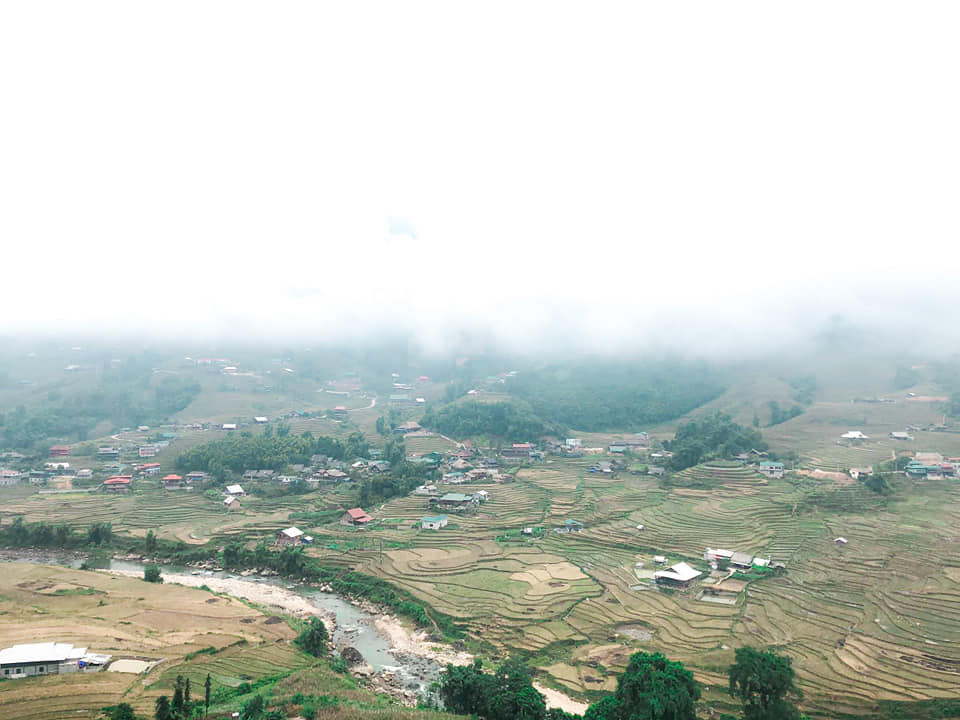
With rustic stilt houses, charming narrow paths, and lush green rice fields that captivate the eyes, Ta Van Village is a particularly special destination for those who love immersive experiences or seek a moment to slow down and find peace in their souls. For years, the local people of Ta Van have regarded distant tourists as guests visiting their homes, coming and going without disrupting the quiet and peaceful farming life.
Ta Van Village is one of the highly favored destinations in the Sapa travel itinerary for tourists. Sapa is a mountainous town in Lao Cai province. With the most majestic natural scenery in the North, Sapa is also known as the “meeting point between heaven and earth.” It is a gathering place for numerous ethnic minority groups who have inhabited the region for generations. The harmonious blend of natural landscapes, cool and fresh climate, and rich cultural identity makes Sapa a famous tourist destination, attracting both domestic and international travelers.
Where is Ta Van Village?
Ta Van Village is located about 8km south of the center of Sapa town, at the foot of the Hoang Lien Son mountain range. There are documents stating that the distance from Sapa town to Ta Van is 11 – 12km, however, the actual distance can vary depending on the route you choose, as there are many different roads.
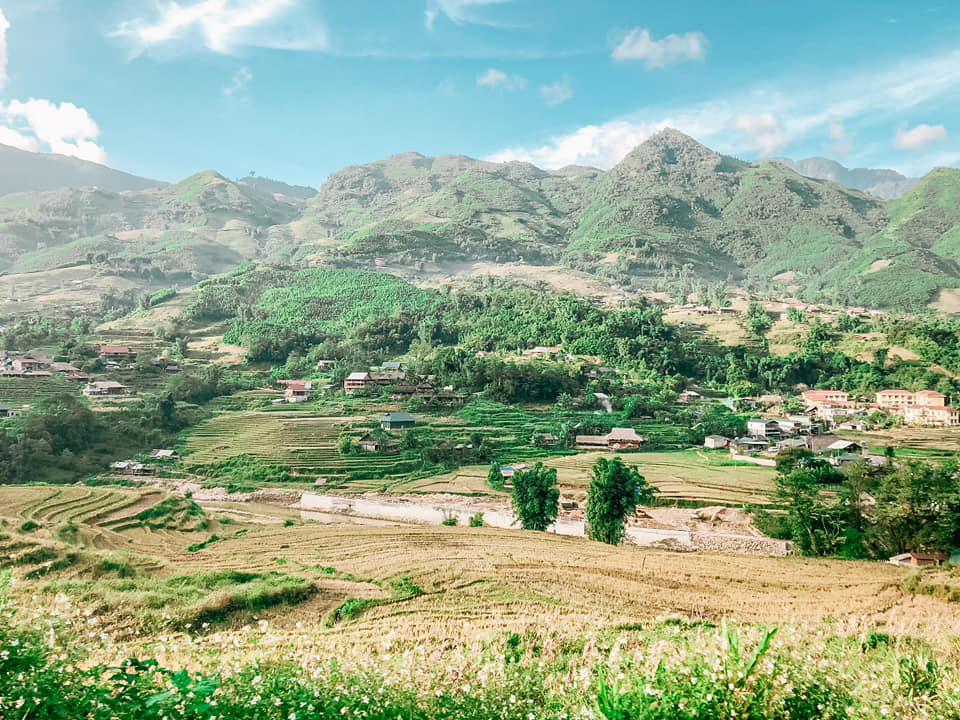
The road to Ta Van Village is quite easy. From the center of Sapa town, you just need to go through Cau May street and Muong Hoa street, then follow the Muong Hoa stream, and you will reach the ticket checkpoint. From this checkpoint, you will be instructed on the way to Ta Van Village. At the beginning of Ta Van Village, there is a red iron bridge crossing the Muong Hoa stream.
Especially, on the way to Ta Van Village, you will pass through many famous tourist destinations in Sapa such as Lao Chai village, ancient rock field… so it is very convenient for tourists to visit and explore.
Historical Origin of Ta Van Village
Ta Van Village is the home of the Mong people, Dao Red Peole, and Giay people. However, according to records, the Giay people were the earliest settlers in Ta Van Village. Specifically, Ta Van Village has a history of the Giay people living there for over 300 years. The earliest family lines, according to the elders in the village, are the San family, followed by the Vang family, the Lu family, and subsequent families. These family lines reside closely together in the village, at the foot of the mountain, along riverbanks, and near streams.

Initially, there were only a dozen roofed houses, but over time, people from other ethnic groups such as Mông and Giao Đỏ came to live, forming the bustling Ta Van Village as it is today. Despite the presence of other neighboring ethnic groups, the Giáy people in Ta Van Village have preserved the integrity of their traditional cultural values in customs, habits, beliefs, and festivals.
Best Time to Travel to Ta Van Village
At any time of the year, Ta Van Village has its own unique beauty, offering interesting experiences for visitors.
- From December to February is the coldest time, with the possibility of frost and snowfall. This is also the time when cherry blossoms and peach blossoms bloom all over the village, creating a particularly poetic beauty for Ta Van Village.
- April and May are the seasons of water pouring over the terraced fields. The shimmering water reflects the entire sky like a large mirror.
- September and October are the seasons of ripe rice on the terraced fields, and the whole Ta Van Village seems to be adorned with a new vibrant golden coat, incredibly eye-catching.
In summary, the best time to visit Ta Van Village depends on your purpose, whether it’s for snow, flowers, or rice. However, if you have never been here, you can travel to Ta Van Village at any time of the year; the natural beauty and the people here are sure to leave you satisfied.
Means of Transportation when Traveling to Ta Van Village
Traveling to Sapa
To visit Ta Van Village, travelers first need to go to Sapa. Sa Pa town is only 38km from Lao Cai city and 376km from Hanoi. If you are not from Hanoi or the northern region, you need to fly to Hanoi, and then travel to Sapa from there.
To get to Sapa by passenger car: The ticket prices for passenger cars from Hanoi to Sapa vary from approximately 230,000 VND to 300,000 VND per person per way. The buses depart from My Dinh bus station, Gia Lam, and the journey takes about 5-6 hours on the expressway.
Additionally, you can book tickets through open tour companies such as Queen Café, Hung Thanh, Sao Viet, etc., or purchase a combo of bus and hotel through travel agencies.
By private car: If you are looking for a quick, safe, and comfortable transportation service, hiring a private car with a driver in Hanoi is the best choice. With the private car service from DanangPrivateCar.com’s, you will be picked up at your location by a professional driver with years of experience, ensuring the safest journey. Book your private car from Hanoi to Sapa today.
To Sapa by train: Trains depart at 9 pm or 10 pm from Hanoi and arrive in Lao Cai city the next morning. From Lao Cai city, you can take a bus or passenger car/taxi to Sapa. The train ticket prices vary depending on the seat class (hard seat, soft seat, air-conditioned, etc.). Typically, it ranges from 150,000 VND per person for a hard seat to about 280,000 VND per person for a soft seat. The price for a sleeper berth starts from 480,000 VND per person.

Traveling from Sapa to Ta Van
As Ta Van Village is quite far from the center of Sapa, visitors often hire motorbike taxis, taxis, or small cars to reach Ta Van.
Most hotels in Sapa offer vehicle rental services and guidance on transporting guests to tourist destinations, including Ta Van. Therefore, if you are traveling to Sapa independently, you can book a vehicle from your hotel or ask the hotel where you stay to rent a motorbike or car to Ta Van.
The price for a motorbike rental in Sapa, like other tourist destinations, is around 120,000 VND per day for manual bikes and 150,000 VND per day for automatic scooters. As for cars, you can calculate based on the mileage on the car’s meter or negotiate in advance with the driver, usually around 500,000 VND for a round trip from Sapa to Ta Van.
However, you should note that if you are traveling in a large group and want to rent a car, you should only rent a car with fewer than 16 seats, as large cars are not allowed in the village.
Tourist Experiences in Ta Van Village
As one of the hottest destinations in Sapa, there are countless experiences you shouldn’t miss when traveling to Ta Van Village.
Beautiful Natural Landscape in Ta Van Village
When you arrive in Ta Van, the first impression is undoubtedly the magnificent and peaceful natural painting of the Northwest mountains and forests. The sounds of forest birds, the murmuring stream, winding terraced fields, characteristic stilt houses… All of these elements will immerse visitors in sheer awe. The breathtaking scenery of nature will bring tranquility to your soul, washing away the weariness of the bustling city.

Admire the Terraced Fields in Ta Van
The winding terraced fields on the hillsides and mountainsides are an impressive feature in Ta Van Village. The best times to admire the beauty of Ta Van’s terraced fields are during the water pouring season in May-June and the ripe rice season in September-October. However, in other months, the landscape of the terraced fields with lush greenery is still captivating for visitors.
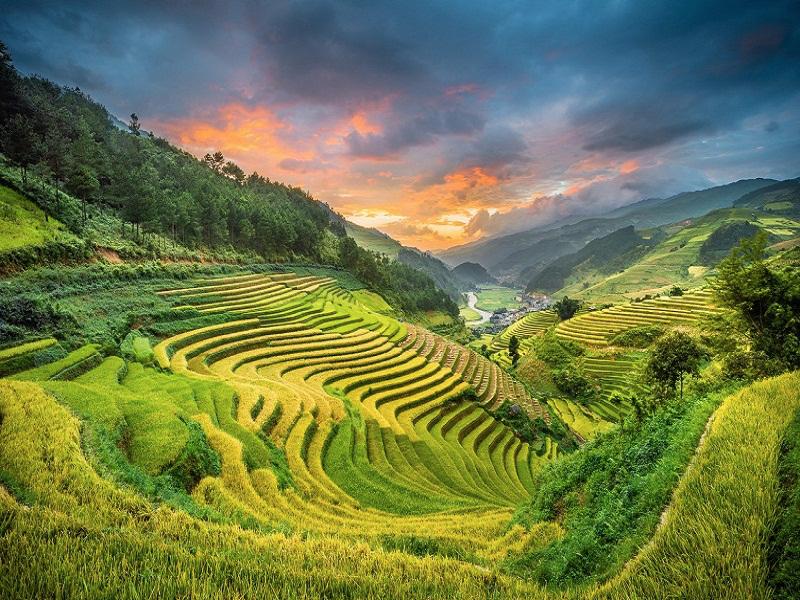
Visit the Houses of Ethnic Minorities in Ta Van Village
The ancient houses along the roadside give Ta Van a unique beauty, both simple and rich in cultural identity. These houses are beautifully constructed, and the residents keep them neat and clean. Some beautiful ancient houses worth visiting for photography include the houses of Mr. Lồ A Mục, Hoàng Din, etc. Among them, Mr. Lồ A Mục’s house, built in 1934, is a typical wooden house with an earthen floor of the Giáy people. Visiting here, you will gain insight into the life and culture of the local ethnic communities.
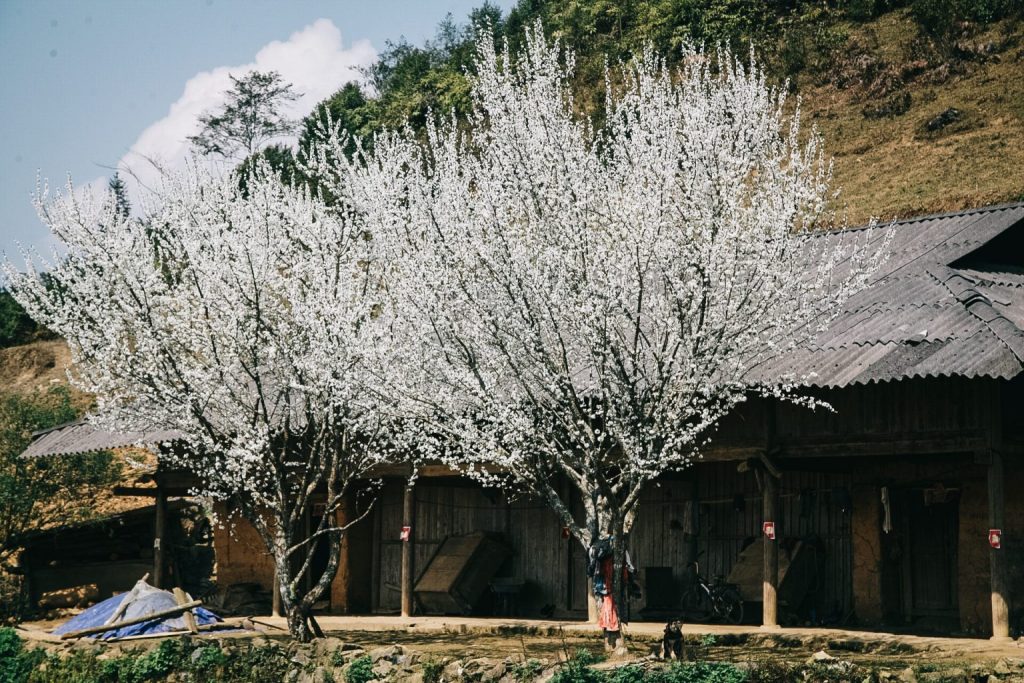
Take Photos in Traditional Costumes of Ethnic Minorities
Wearing traditional costumes with vivid colors and unique designs of ethnic minorities, standing amidst terraced fields, stilt houses, or crossing bridges over streams, will undoubtedly provide you with new experiences and timeless photos. The rental cost for costumes in Ta Van is very affordable, ranging from 30,000 to 50,000 VND per set, with a variety of styles and colors for visitors to choose from.

Stay in Beautiful Homestays in Ta Van Village
It is recommended to spend at least one night in the village to fully experience the local culture and life. Currently, Ta Van Village has numerous homestays catering to the accommodation needs of both domestic and international tourists. These homestays typically feature stilt house architecture, offering fully-equipped facilities and various room types from dormitories to single, double, and bungalows, with rental prices starting from 100,000 VND per person per night. Waking up in the fresh air, with the melodious sounds of birds, the majestic misty Hoang Lien Son range, and the romantic Mường Hoa stream, is an experience that travelers should try at least once in their lifetime.

Explore and Shop at the Local Markets
The lively and colorful scene of traditional costumes and indigenous handicrafts will undoubtedly leave an unforgettable impression on visitors. If you want to buy local specialties, unique souvenirs as gifts for family and friends, or simply experience the native culture, the local markets are a must-visit destination.
Check-in at Cau May (Cloud Bridge) in Ta Van Village
Cau May Sapa, which has caused a stir on social media, attracts the attention of tourists both domestically and internationally. In the past, locals used to create bridges made of forest vines and thin wooden planks to cross rivers and streams. Nowadays, due to development, these bridges leading to Ta Van have been replaced with iron for safety. Cau May is a rare bridge that has been preserved to this day, mainly serving the sightseeing needs of tourists. If you want to walk to the middle of the bridge for photos, be careful as it can be challenging to traverse, especially during the rainy season when the thin wooden planks can become slippery, posing a danger to visitors.

Enjoy Local Specialties in Ta Van Village
There are numerous delicious dishes you should try when visiting Ta Van, such as “thịt lợn cắp nách” (pork armpit), grilled Mường Hum stream fish, colorful sticky rice, horse meat hotpot, etc. Compared to many other tourist destinations, the cuisine in Ta Van, and Sapa in general, is praised for catering to the tastes of the majority of visitors. Moreover, Ta Van now has many excellent eateries, so you can entirely trust the quality of the food here.
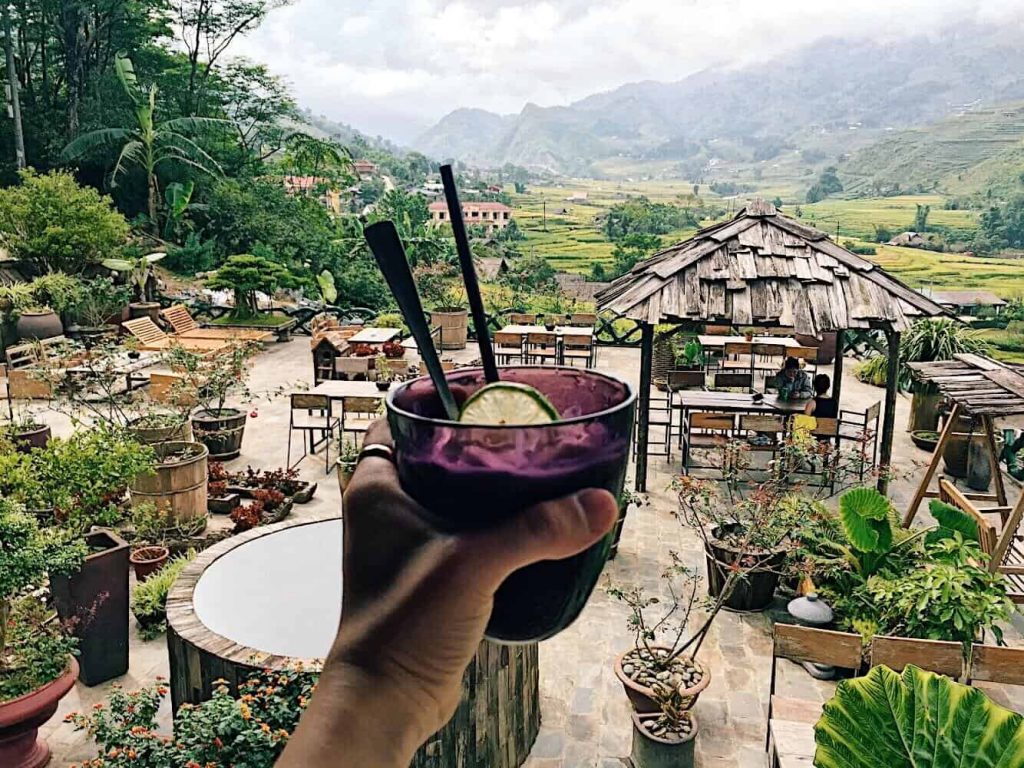
Tourist Attractions near Ta Van Village, Sapa
Lao Chai Village
Located 7 km from the town of Sapa, Lao Chai Village is similar to Ta Van Village, preserving traditions from generations of ethnic communities.
Fansipan Peak
One of the highest mountain peaks in Vietnam. Many Sapa travelers aspire to conquer the roof of Indochina. Now, you have an easier way to reach the Fansipan Mountain without the strenuous mountain climb—take the cable car.

Stone Church
Situated in the center of Sapa town, the Stone Church of Sapa features French architectural influences. In front of the church is the central square where weekend Love Markets take place.

Cat Cat Village
Considered the most beautiful village in the Northwest, about 3 km from Sapa town. Cat Cat Village is a must-visit destination in Sapa, offering picturesque views of cool streams, picturesque bridges, and waterwheels bringing water to the village.

Delicious dishes that will make you forget your way back when visiting Ta Van Village include Muong Hum grilled stream fish, Muong Khuong horse meat hotpot, Bac Ha armpit-stolen pork, and Van Ban five-color sticky rice, dishes prepared from corn, glutinous rice, buckwheat, chicken meat, among others. Tourism in Ta Van Village has developed significantly, accompanied by numerous restaurants and eateries, so you don’t have to worry about finding good places to eat. Rest assured that when leaving Ta Van Village, you will be fully satisfied with the delicious and memorable local specialties.
Enjoying Local Specialties in Ta Van Village
Grilled Stream Fish
Sapa stream fish comes in various types and notably lacks a fishy taste. When traveling to Sapa, grilling stream fish involves simply grilling it over charcoal until cooked and then serving it hot. Another method is to grill and deep fry it with tomato sauce and spice blends such as curry powder and black pepper.
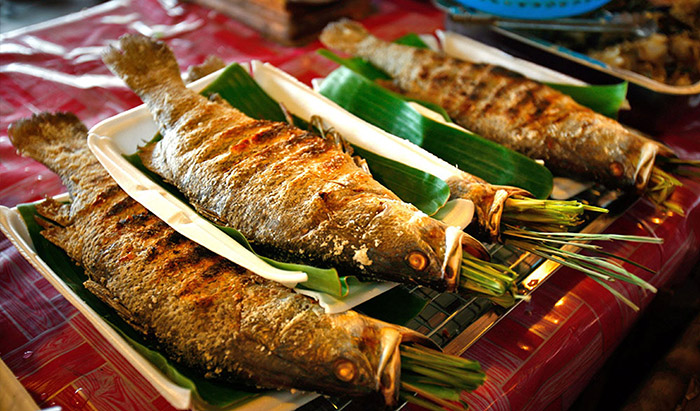
The fish often has a green color to camouflage in mossy rock crevices. Stream fish has many bones, so people in the highlands prefer to grill it until crispy to eat both the bones and meat. Dipping the fish in delicious fish sauce with lemon and enjoying it with boiled mustard greens and hot rice in a cold Mường Hum night creates an exquisite sensation.
Apart from crispy fried fish, locals also love stir-frying fish intestines. They consider it a delicacy and a folk remedy for men’s health and women’s beauty.
Thang Co
Thang Co is a common and indispensable dish among the ethnic groups in the Northwest region, especially in the highland ethnic markets. Traditional Thang Co is originally made from horse meat, and later variations include beef, buffalo, and pork, creating various types of ingredients. However, the most delicious Thang Co is still the one made from horse meat in the regions of Bac Ha, Muong Khuong, and Sa Pa.
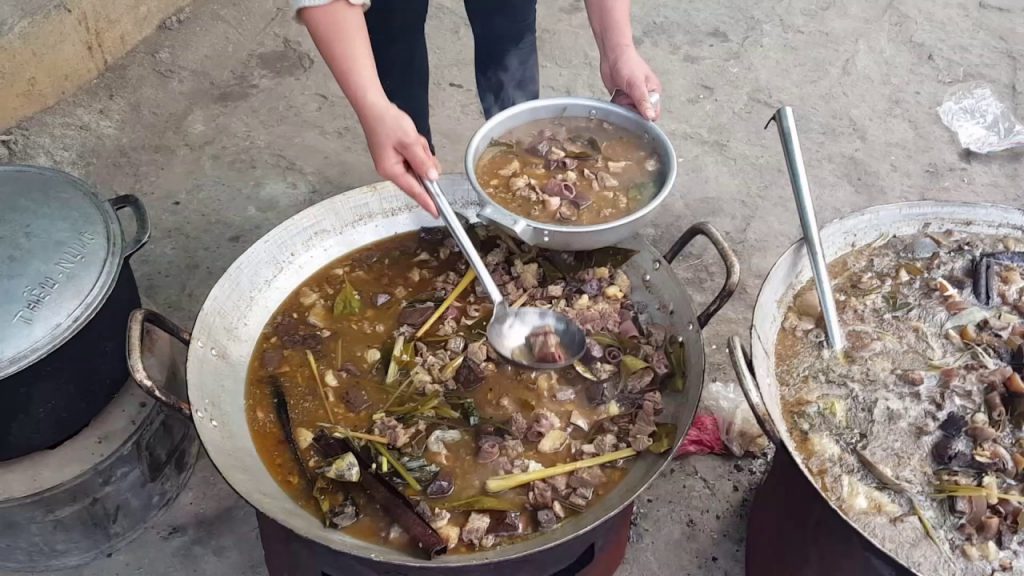
The traditional Thang Co pot includes horse meat, heart, liver, lungs, horse blood, and 12 other traditional spices. Among them, “thang co” leaves are the 12th spice. The Thang Co dish is prepared quite simply.
When eating, people scoop the broth into a hotpot, cut the horse meat into pieces, and put it in. Accompanying vegetables include cat’s ear plant, ngong su hao (a type of local vegetable), and hot pot cabbage. The dipping sauce is made from a special chili sauce with a salty, spicy, and pungent taste, providing a warming effect when consumed. Cleanly processed horse organs have a very fragrant taste, being crisp and delicious. The distinctive flavor of horse meat, with its chewiness and sweetness, blends perfectly with the dipping sauce.
Bac Ha Armpit-Stolen Pork
The Bac Ha stolen armpit pig is raised in a natural and free-range environment, living in gardens and foraging for wild vegetables and roots instead of being fed, bathed, and sleeping in a sturdy pen like other pigs. These pigs are usually raised freely for about 1 year, with the largest weighing only 20 kg, and the average around 10 kg. Bac Ha stolen armpit pork is very firm, sweet, and especially low in fat, with a pleasant aroma instead of the unpleasant odor of commercially raised pigs. The feeling of eating Bac Ha stolen armpit pork is not as greasy as eating fatty pork, and it is not dry due to toughness like wild boar meat but remains tender. Typical dishes prepared from Bac Ha stolen armpit pork, such as whole grilled pork, grilled hot pot, etc., are delicious. If you want to make stir-fried, steamed, or grilled dishes, it will still be delicious. Bac Ha stolen armpit pigs are mainly sold at highland markets, where ethnic people often gather and exchange goods on weekends. When grilling Bac Ha stolen armpit pork, Cuong advises you to brush honey all over the pig while grilling. Honey helps the pig’s body not crack when roasted and gives it a shiny golden color that is very eye-catching.
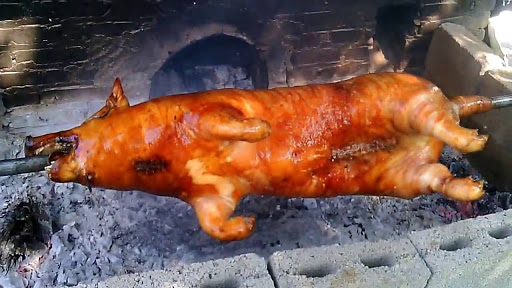
Grilled Village Chicken
Village chickens are raised freely by ethnic minorities, foraging for food in the mountainous areas. When in Sapa, Cuong tasted the grilled pepper and lime village chicken, a dish you must try. The chicken meat is fresh, fragrant, and tender. When eating, tear a piece of chicken with your hands and dip it in a spicy, fragrant, and luscious sauce—a delightful sensation!
Some notes when traveling to Ta Van Village, Sapa
- Because Ta Van Village is located in the high mountains, when traveling, you should prepare warm clothes. Ta Van can be very cold in winter, while spring and summer are warmer.
- If you plan to stay and explore Ta Van Village for a few days, it’s advisable to bring your ID for temporary residence registration.
- In addition, the road to Ta Van Village is quite winding, so if you have a history of motion sickness, consider taking motion sickness medication or choose means of transportation by motorbike.
- If you visit Ta Van Village during the peak tourism season, it’s recommended to book homestay accommodation in advance.
- As the terrain in Ta Van Village is mostly hilly with many streams and rugged roads, it’s advisable to travel in groups, stay close to each other, and ensure safety, providing timely assistance in case of any incidents.
- Prices for food here are relatively high. A grilled chicken weighing about 2kg costs 500,000 VND, a plate of grilled stream fish is…, so for those who travel independently and want to save costs, it’s recommended to prepare food to bring or return to the town to eat.
Above is a summary of the travel experiences to Ta Van Village Sapa for your reference. We hope that with the shared information from DanangPrivateCar.com’s, you will gain additional useful insights for your journey to explore this misty town.

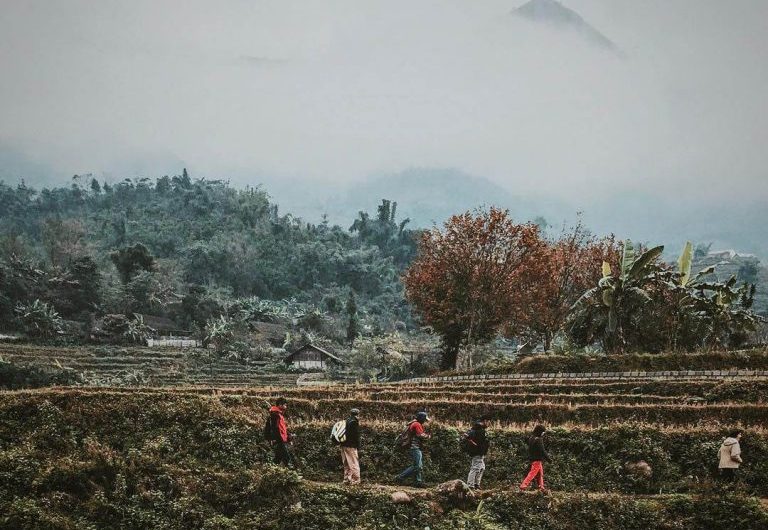
Comments